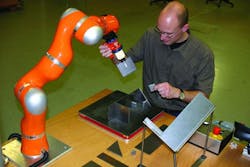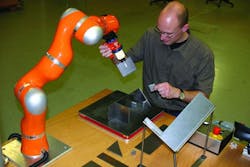Award-Winning Robot Works Safely With Humans
The Kuka-DLR Lightweight Robot (LWR), designed to imitate a human arm while being safe to operate around humans, is the winner of this year’s euRobotics Technology Transfer Award, which was decided at the European Robotics Forum held earlier this month in Västerås, Sweden. A jury of 340 robotic specialists chose winners among finalists for their collaboration between research and industrial partners leading to outstanding innovation with proven potential for significant economic impact.
The winning robot was designed jointly by Kuka and the Institute of Robotics and Mechatronics (DLR). “Being developed over more than a decade, it is mature technology that could open up numerous robotic applications in our daily life, such as in manufacturing, services and medicine,” said Martin Hägele, a jury member and head of the Department of Robot Systems at Fraunhofer IPA.
The LWR was developed to imitate a human arm’s dexterity, sensing and strength. It is also less dangerous and easier to program than existing robots, making it ideal for tasks that require close human-robot interaction. It is more portable and energy-saving than robots with comparable payloads, making it particularly suitable for mobile robot applications.
“We are committed to cooperative working between robots and people, so this means you can touch our robot anywhere and still be safe, thanks to the torque control we’ve built into the joints,” said Ralf Koeppe, head of R&D at Kuka Robotics. “We’ve succeeded in combining safety and force with vision to create a robot capable of learning through demonstration, yet still accurate to just tens of microns. The LWR is the first robot to be rated safe to operate without a protective fence—a historic milestone. We believe the world is now our oyster in developing applications for LWR and its variants.”
Second prize went to 3B Scientific’s SIMone, a interactive robotic birth simulator, developed by TU München, ETH Zurich and 3B Scientific. SIMone aims to reduce the number of caesarean sections and incidence of cerebral palsy as a result of incorrect use of forceps and vacuum extraction. At the core of SIMone is a force-controlled kinematic structure, which is actuated to rotate the baby realistically as it moves through the birth canal with position and force sensors to record forces and torques applied by the forceps or vacuum tool. The physiological model incorporates forces generated by friction, elastic tissues, uterine contractions and the user’s attempts to extract the baby. 3B Scientific has already sold 50 systems worldwide of this advanced training tool for medical students and doctors.
The other finalists in the euRobotics Technology Transfer Award were Fits.me, an Estonian startup company that has, jointly with Tallinn University, developed an online fitting room for clothing retailers using robotic mannequins; Surgenius, a surgical robot developed by Surgica Robotica and the University of Verona; and Workerbot, a human-inspired, dual-armed robot created by a collaboration between pi4_robotics and Fraunhofer Institute for Production Systems and Design Technology, IPK.
“We have never had so many different robotics fields represented in the Technology Transfer session,” said Henrik A. Schunk, managing partner of Schunk and chairman of EUnited Robotics. “It shows that robotics technology is penetrating more and more fields and markets.”


